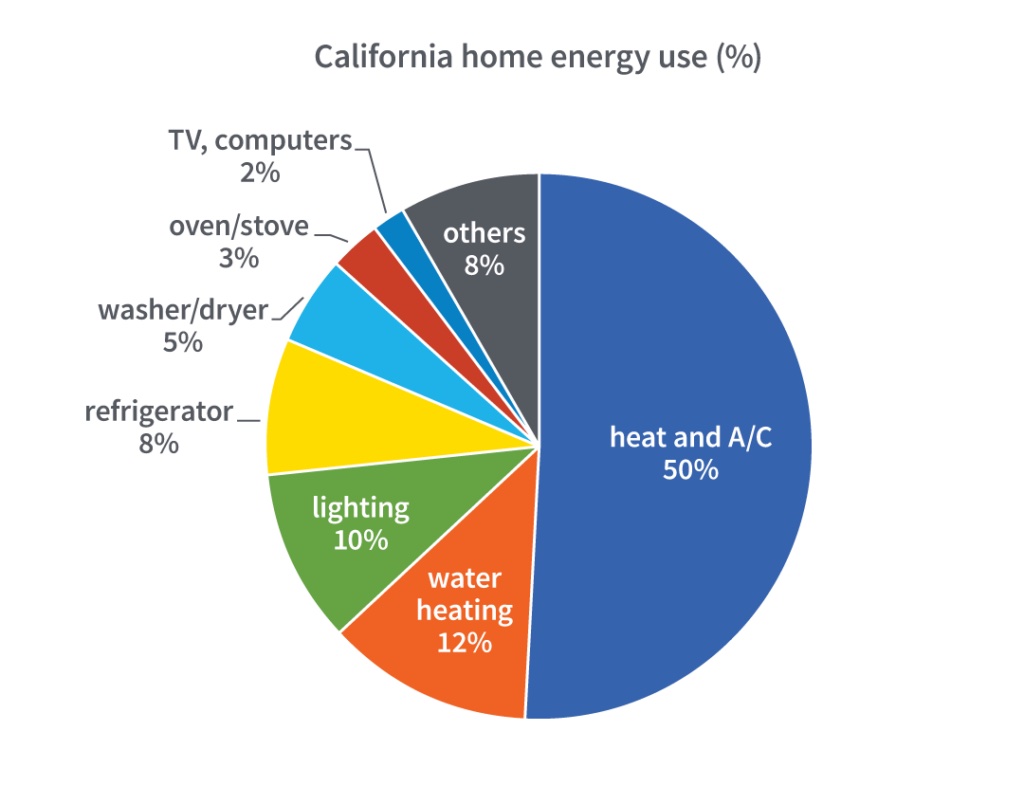
Energy bills can rise – sometimes dramatically – during the winter due to several factors. For example, colder weather and shorter days can result in higher energy use, even if you’re away part of the time on vacation. Why does this happen and what’s using all the energy? The graph shows how energy is used in a typical California house.
The largest use of energy in California homes, typically, is for heating, ventilating, and air conditioning, which can account for about half of the energy use. Hot water and lighting are the next largest users of energy, at 10-12% each. Refrigeration consumes about 8%. After that, washers and dryers use about 5%, oven/stove about 3%, TVs and computers about 2%, and other appliances combined about 8%. These are average or typical amounts for annual use, and will vary depending on factors such as: number of people in the household, daily use patterns, the type of appliances used and their energy efficiency.
Weather is a major driver of energy use
When the temperature dips, heaters kick on and energy use can quickly increase. Most homes are heated with methane gas, and cold weather can cause the amount of gas used to spike from 20-40% from one month to the next. Additionally, during cold, rainy weather, people tend to stay inside more. They may cook and bake more, and the energy use for hot water often increases. There is a clear pattern between the fluctuation in temperature between the seasons and the use of energy in the typical home.
Shorter days
In the winter our lights use more energy to keep our homes lit during longer nights. This can include outdoor lights, which may be on longer during winter months. We head indoors earlier where we shift to indoor activities, leading to a rise in the use of electronics (e.g. TV, media devices, computers).
“But I was away on vacation!”
People are sometimes surprised to receive a high bill if they have been away from their house. Changes in weather and other factors during the month could cause someone’s bill to be higher when compared to the prior month, for example. And even while on vacation, heaters may run, lights may be on timers, and refrigerators, electronics (TVs, computers), and water heaters continue to use some energy, even when on standby.
Changes in rates
While the energy bill amounts in winter are typically impacted most by weather, changes in rates may also be a factor. Since most homes have not yet converted from methane gas to high-efficiency electric heat, changes in the price of gas have a greater impact on energy bills in winter. Check your energy bill to see what how much is from electricity and how much from gas. The bill also shows the change in energy use when compared to the prior month and prior year. There are many actions you can take to reduce your energy use, including:
- Weatherization: seal air leaks and add basic insulation
- Close curtains to reduce heat loss through windows
- Replace old lightbulbs with more efficient LEDs
- Lower thermostats (save ~5% per degree), use smart or set-back thermostats at night or when you are out of the house
- Turn down water heaters to 120-degrees F
- When purchasing appliances, choose those that are more energy-efficient
- Take advantage of lower rates: Most people are on a time-of-use rate and can shift electricity use to off-peak hours when rates are lower. Learn more about time-of-use here (most residents are already on a time-of-use rate).
- Convert gas appliances to more efficient, all-electric heat pump appliances (heaters, water heaters, dryers); check here for appliance rebates
For more information about how you can reduce your energy use, click here For more information and help lowering your bill click here